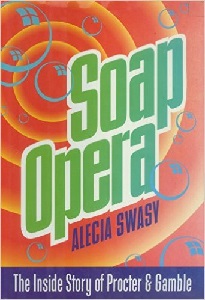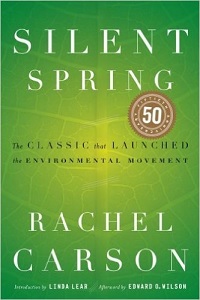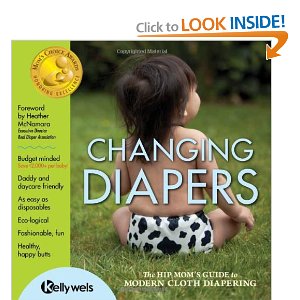
|
|||||
|---|---|---|---|---|---|

|
|||||
Virtually every product we purchase will have some impact on our environment. The challenge to us, as a contentious consumer, is to determine which of the alternatives are less harmful, and to choose to use these products and practices whenever possible. Being informed and including environmental considerations in our decision-making is essential.

Soap Opera : The Inside Story of Procter and Gamble |
Yet, how can the average consumer compare a ton of solid waste produced by throwing away disposable diapers with, say, a million gallons of wastewater produced by washing cloth diapers? And which is worse: 10 pounds of nitrogen oxides or 1,500 parts per million of hydrocarbons?
Here is the conclusions that three studies came to, of which two were funded by the Disposable Diaper Industry:
SOLID WASTE - POST-CONSUMER1
• Re-usable cloth diapers - 59 lb./ per 1,000 diaperings
• Disposables - 442 lb./per 1,000 diaperings
WATER USAGE11
• Home Laundered - 4,383 gallons/per year
• Diaper Service - 2,772 gallons/per year
• Disposables - 70 gallons/per year
ENERGY USAGE - million BTU/per 1000 diaperings11
• Home Laundered - 6.87
• Diaper Service - 3.84
• Disposables - 3.37
AIR POLLUTION - (lb. of atmospheric emissions/per 1,000 diaperings)11
• Home Laundered - 17.2
• Diaper Service - 8.0
• Disposables - 8.3
All annual figures above are based on 3,514 cloth diapers used in one year and 1,963 disposables, as extrapolated from the Lehrburger study. 13 That works out to 9.63 cloth or 5.38 disposable diaper changes per day.

Silent Spring |
However, it is *extremely* important to note that the above numbers cited *do not* include manufacturing and *do not* include transportation. Including the cost to manufacture, package and transport 36 cloth diapers compared to 6,500 disposable diapers, for just one baby's use, would make quite a bit of difference to the above figures.
Further, they do not compare the amount of land required to produce raw materials, to dispose of the subsequent garbage, etc. Nor do they measure or compare the *impact* or effect on the environment. They do not attempt to assign greater importance to highly-toxic substances; emissions or effluents are measured and totaled by volume or weight, whether they are toxic and persistent, or benign and biodegradable.2
In fact, one particularly formidable finding was the report financed in the UK by the Women's Environmental Network (WEN) - a neutral advocacy group. Their 1991 report prepared by the Landbank Consultancy Group compared both of the Lenz and Little (Proctor + Gamble funded) studies and even used their own statistics, and yet they still found that disposables use 20 times more raw materials, 3 times more energy, 2 times more water and generate 60 times more solid waste
than do cloth diapers. 9
Pesticides and Bleaching
- Cotton, of course, is not without its evils. Conventionally grown, it is a major user of harmful pesticides, as well as herbicides, fungicides and defoliants. 8
Some concern has been stated that the use of pesticides, etc. would increase with a shift towards reusable cotton diapers. However, even if every single disposable diaper were replaced with a 100% cotton diaper, the impact on the cotton industry would be minimal as cotton diapers would still represent just a small fraction of the total cotton market. 12
Cotton diapers also use chlorine-based bleaching during manufacturing and, in the past, parents have used chlorine bleach in their quest for that perfectly white diaper. However, the environmental impact of chlorine bleaching paper products is *far greater* than the chlorine bleaching of diapers in a diaper service or at home. 9
Bleach is not necessary and most cloth diaper manufacturers will tell you *not* to use bleach on their products.

Whitewash - Exposing the Health and Environmental Dangers of Women's Sanitary Products and Disposable Diapers |
Land Usage
- Cloth diapers make more efficient use of raw materials and the managed land needed to produce them.2
An estimated 460 square kilometers of land (180 mi.2) are required to be under human management for the sole purpose of growing trees to diaper just 70% of Canada's babies in disposable diapers.3
To diaper the same number of babies in home-laundered cloth diapers would require 17 square kilometers (7 mi.2) of land to grow the cotton.4
The more land that has to be under human management to meet human needs, the more bio- diversity and wildlife habitat is lost. Our demands for products that require the use of land (such as food, paper, lumber and textiles) far exceed the supply from existing tree farms and other managed land, resulting in the clear-cutting and altering of more of our natural areas. If we are to stop or even slow down this practice, we must start meeting our needs in ways that make more efficient use of raw materials and the land that produces them.6
Energy
- In total, cloth diapers use emits more air pollution. However, the air pollution from the manufacture of disposable diapers is far more noxious. Pulp bleaching emits dioxins and furans into the air, as does incineration.1
Heated drying accounts for about 1/3 of the energy used and related air emissions produced for home laundered cloth diapering (Many forms of energy productions, such as coal burning, result in the release of air emissions.) Choosing diapers with a relatively short drying time will help keep energy consumption down. Also, if circumstances permit, diapers can be hung to dry in the sun.2

The Sanitary Protection Scandal |
Laundry
- Estimated on an average of 6,500 diaper changes, washing 24 diapers (plus the required covers, cloth wipes and liners) per wash load for a total of 271 loads. At 1/2 cup of soap or detergent per wash load , you will use 136 cups.2
In the past, detergents contained a non-biodegradable surfactant 14 , resulting in the accumulation of foam on banks of rivers. By the late 1960's, a biodegradable surfactant was used. However, the phosphates contributed to the growth of algae. Rotting algae can lead to eutrophication (death
) of a lake. The Canadian government set a limit of 5% on phosphates used in detergents. 15 Today, most detergents are phosphate-free.
Water and Sewer
- Washing cloth diapers at home uses 225-310 litres (50-70 gallons) of water every three days. 2 Estimated at 4 toilet flushes for dunking messy diapers - 16 gallons. One normal wash cycle - 45 gallons. Rinsing and filling the pail to soak diapers - 7 gallons. Total - 68 gallons/per wash load. Therefore, 6,500 cloth diapers would create the total water usage for one baby's diapers of 18,428 gallons.
For perspective, a toilet-trained person, flushing the toilet 5-6 times a day, also uses about 300 litres (68 gallons) every three days. 5 To cut down on the toilet ducking, flushable diaper liners can be used and discarded with feces. Installing a water-saving dam or valve is another option, and would achieve greater water savings for the entire household. 2
The waste water produced from washing diapers is benign, more readily treated and pose less of a threat to the environment and public health. While the waste water generated from the manufacture of the pulp, paper and plastic used in disposable diapers contains dioxins, solvents, sludge and heavy metals - pollutants considered hazardous to our health. 7,10

50 Things to Know About Modern Cloth Diapers |
Energy
- For the natural gas used to heat the wash water - 20 cu.ft. per wash load = 5,420 cu.ft. For the power to run the dryer - 5.76 kWh per load = 1,561 kWh. For the power to run the washing machine - 0.76 kWh per wash load = 206 kWh. 2
[Unfortunately, the energy to manufacture 6,500 disposable diapers was not readily available in my research for this article - but if I am able to locate this information, I will add it to this article at a future date.]
In 1986, disposable diaper manufacturers reduced the volume/thickness of their diapers by 50% and packaging by 90%, with the introduction of absorbent gelling material and the use of polybag packaging and diaper compaction before packaging. 16 In 1994, they further reduced by about 30% the thickness and amount of material in the diapers.
Despite this, in Seattle, disposable diapers have been found to have increased from the 2.5% of all residential waste in landfills in 1988-89 to 3.3% in 1994-95, according to the Residential Waste Stream Composition Study by the Cascadia Consulting Group.
Although opinions differ as to whether the garbage crisis
is real or reactionary, it is well established that more solid waste is being generated each year, that we are running out of convenient places to dispose of it, and that dumping fees continue to increase steadily.17
All methods of dealing with garbage have their disadvantages. Incineration often produces toxic air emissions and toxic ash. Even recycling has serious limits if not preceded with the practices of reduce and reuse
as the market for recycled products fills up just as landfill sites do, 18 resulting in the indefinite storage, or sometimes disposal of carefully-separated recyclables. Stated in simple terms, it would be wise to quit buying and tossing out so much
*before* a crisis becomes obvious. 2
No diapering method, or any other industrial endeavor, is without environmental impact. But what will the environmental future hold for the earth if we do not reduce, reuse and recycle, in as many ways as possible, as often as possible?

Changing Diapers: The Hip Mom's Guide to Modern Cloth Diapering |
• Consider buying green
, hemp or organic diapers to avoid the pesticides, etc. normally used in the growing of conventional cotton.
• Use flushable liners (or thin reusable cloth liners) to avoid having to toilet dunk messy diapers. If you are exclusively breast-feeding, you don't need to toilet dunk at all - let your washing machine deal with the poop.
• Do not soak your diapers. This is not necessary, and can shorten the life of your diapers, depending on what additives you would add to the soaking water. Use a dry pail to store your diapers until wash day.
• Always wash a full load of diapers - 24 diapers, plus the required covers, cloth wipes and diaper liners. Smaller loads use more water. Make sure you have enough diapers to last at least three days between washings.
Use a bio-degradable, non-phosphate detergent, or a vegetable-based soap to wash your diapers. Do not use fabric softeners - they lessen the absorbency of your diapers and can allergic reactions in sensitive babies.
Instead of bleach, which can shorten the life of your diapers, use hydrogen peroxide, an environmentally friendly alternative, for whiter diapers. Or hang diapers in the sunshine for a *free* bleaching with absolutely NO environmental impact.
Choose diapers that can be washed in one wash load, preferably with an all-cotton content for ease of washing and rinsing - without having to use several washing cycles to get the diapers thoroughly clean and sweet-smelling.
Choose diapers with a short drying time, and line dry if possible. Even in an apartment, a portable drying rack can be set up inside to dry diapers.
Management Land Requirements, Reusable Cotton vs. Paper Pulp for Absorbent Core of Diapers,Report to the Product Environmental Assessment Consultation of the Niagara Institute, January 1993. Addendum: Canadian Requirements.
The Disposable Diaper Myth, Whole Earth Review. Fall 1988:61.
The Joy of Cloth Diapersby Jane McConnell, Mothering, May-June 1998.
Diaper Changes: The Complete Diapering and Resource Guide, Richland, Homekeepers Publishing, 1997
Energy and Environmental Profile Analysis of Children's Disposable and Cloth Diapers, Franklin Associates Ltd. (1990)
Reusable Cloth Diapers- Environment Canada
Both Sides Now- Doug Smitheman and K. Amies, Alberta Parent, March/April 1991
Canadian Consumer, April 1986, pg. 25
The Solid Waste Dilemma: An Agenda for Action, Municipal Solid Waste Task Force, 1989 EPA/530-SW-89-019
Rubbish!, The Atlantic Monthly, December 1989
This article compliments of Born to Love.
Send questions, comments, and suggestions to: catherine@borntolove.com
Born to Love articles are written by Catherine McDiarmid-Watt
Born to Love is a participant in the Amazon Services LLC Associates Program, an affiliate advertising program designed to provide a means for sites to earn advertising fees.
NOTE: All logos, company names, brands, images, trademarks and other intellectual property are the property of their respective owners.
Born to Love is a participant in the eBay Partner Network, an affiliate advertising program designed to provide a means for sites to earn advertising fees by advertising and linking to eBay.com.
Copyright © 1978 - BorntoLove.com - All Rights Reserved.
Last updated - April 5, 2024